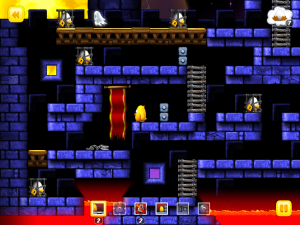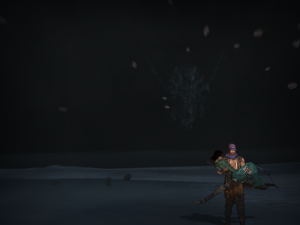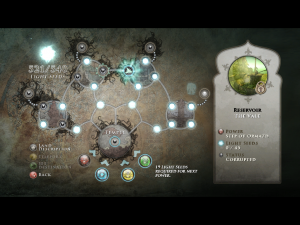Having left the last post in a bit of a cliffhanger, it’s time for a big spoiler. What’s on the other side of the fake ending? The entire second half of the game, it turns out. There’s a teleporter to another castle. Or not quite another castle, because it’s exactly the same layout, the same furnishings and everything, although palette-swapped a bit in places. There are of course different monsters (including a completely new set of bosses, and also a few of the earlier bosses demoted to grunts) and different treasures (including all the items that were taken away from you in the intro, which are pretty much the best items other than rare random drops). Also, it’s all upside-down. The whole castle.
This inversion doesn’t affect the monsters. It does affect all stationary scenery elements, which includes any flames or bodies of water, as well as the sky and the ground, in those places where you can see outside. It has the effect of making you climb to reach the deepest caverns under the castle. It’s basically a lazy way to double the amount of terrain while still varying it in significant ways: a room with an arched ceiling becomes a room with a curved and sloping floor, a pool that was hard to avoid falling into becomes instead hard to reach.
Actually, water is one of the few things that can be hard to reach at this point. By the time you reach the inverted castle, you’ve necessarily gained the ability to turn into a bat. You can’t go through water in this form, but you can merrily fly over the heads of some of the toughest enemies who would otherwise block your way. In extreme cases, like when there’s an endless stream of flying medusa heads in your way, you can turn into mist, although this uses up mana a lot faster than bat-form. Still, the simple ability to skip combat whenever you feel like it is one of the factors that makes the second half go faster than the first. Another is the fact that you already have all the obstacle-circumvention powerups in the game. Another is that, because the second castle is identical in layout to the first (only upside-down), you already know the map, including the locations of secret passages and how to access them. (This cuts both ways: there was one secret passage that I found in the inverted castle first, because it had been on the ceiling before.)
The only real obstacle, then, is the boss fights, which get pretty tough. There are things on the scale of Shadow of the Colossus here; past a certain point, things that don’t fully fit on a single screen become the norm. And I have to take a moment now to remind myself to be impressed with that, that they could spare the resources, both in terms of system memory and development time. It’s easy to take for granted in the post-FMV age, but I can remember being impressed with lesser efforts at the arcade. And the most impressive part isn’t even just the big things: it’s that this game has a roster of enemies as large and diverse as a Final Fantasy of its era, only where FF was using static images for everything but the player characters, these monsters are fully animated. In some cases, particularly with armored foes, it looks like they might be saving some cels by building creatures out of rigid parts that can be rotated independently, now that they could target hardware with native support for bitmap rotation. But there are a lot of creatures that are just animated as full-body bitmaps, and I could be wrong about the game ever doing anything else.
(One trick I have to mention: there are a couple of types of ghostly sword-wielders that spend most of their time invisible. The swords of these beings are always visible, swinging and swashbuckling freely, but the body only appears in brief flashes. This means they can have an elaborate attack routine with only two or three frames of animation, and the poses you can see are carefully chosen to suggest more than they depict.)
Anyway, the second half goes fast enough that I’ve already finished it. This gives one the opportunity to start over in the role of Richter Belmont. I don’t consider this to be necessary for removing the game from the Stack, but I’ve played in Richter mode enough to be impressed with how different it is. It essentially turns the game back into a traditional Castlevania: there’s no inventory or equipment, no mobility upgrades, no leveling or XP. It’s just you, a sacred whip, and one special weapon at a time. Richter even moves with the blocky, shuffling gait of the original Castlevania on the NES, which looks downright silly after Alucard’s more detailed walk animation, with his hair and cloak all flowing and windswept. To compensate for his inability to turn into a bat, Richter gets a free pass on some things that Alucard needed upgrades for, such as opening enchanted doors. Come to that, Alucard needed upgrades just to use some of the basic features of the UI that Richter gets automatically, like having the amount of damage your blows are doing to the monsters displayed on the screen. That’s a kind of upgrade I’d normally expect only in satire.
One thing tempts me to keep on going with Richter, and that’s the thought that all that upside-down terrain would become more relevant with him. He’d have to navigate it all without flying, without even double-jumping. But I suppose he must have some secret hadouken-like combo that lets him clear the larger gaps in the game, or he’d never be able to reach the topmost tower. But I’ve never been much of a one for secret combos. Heck, I barely used the combos I was explicitly given for casting spells. (I’m told that playing through the game without using spells is a common voluntary conduct challenge for those who have mastered the game, and I came pretty close to doing it unintentionally.) What’s worse is that some of the special powers that Alucard can unlock are combos that the game doesn’t even tell you how to use. No, not even in the docs. For example, one grants you the ability to run fast while in wolf form. I have no idea how to trigger this. I managed it once, but only by accident. Apart from one place where you need to shift into wolf form to pass a narrow gap (because Alucard is apparently too proud to crawl), I basically didn’t use wolf form, except as a result of getting confused about which button does which transformation. Because wolf form is basically useless unless you can do the combos.
One combo I used a great deal: the one for the high-jump power, down-up-X. I didn’t figure this out on my own. I resorted to hints. Perhaps it would be more easily guessable by someone steeped in 1997 console-game lore. It certainly seems like the sort of action that would be used in multiple games. I recall that Half-Life did something similar for its long-jump action. The only other time I used hints was to open the rightmost passage in the clock tower, which is something of a riddle. The room is dominated by a working clock face, and there’s a passage on the left that opens and closes at intervals of a minute, so I thought that the passage on the right must have some similar time-based pattern, and spent some time waiting for it to open when the clock hands were reaching significant-looking points. But the trick turned out to be nothing like that, and I doubt I would have got it on my own.
That closed-off passage by the clock was the last of the obvious obstacles for me. There may well be more secret passages that I haven’t found, hidden behind crumbling walls and the like. I suppose I could do a sweep of the castle with the Faerie familiar equipped if I wanted to find them all: as the one familiar who doesn’t participate in combat, the Faerie helps you in other ways, like pointing out frangible walls and feeding you healing potions when you need them. But, having taken a longer glance at some FAQs and walkthroughs now, it seems like discovering absolutely everything is a goal for those more dedicated than me, people who like to play the same game over and over and master its every detail. The game indulges such players by giving them lots of obscure stuff to discover. The Shield Rod combos, for example. The Shield Rod is a bludgeoning weapon that I used for a while, then abandoned when I got a better weapon. Apparently if you use it at the same time as a shield, pressing the weapon and shield buttons simultaneously, it produces a magical effect determined by the type of shield. This is obscure enough that it would come off as an easter egg if it weren’t so elaborate, another of the game’s extravagances. It’s a short step from exploring this kind of content to discovering glitches and exploiting them to break sequence, get outside the castle walls, and similar activities. And there have been people so in love with the game that they put documents on the internet explaining how to do this.
For my part, I may eventully find enough motivation to finish with Richter, but am unlikely to take things farther than that. Life is too short, and the Stack too large.
 Here’s a game that Steam has been pushing relentlessly, including it in various bundles and promotions. It’s priced at $5, but it keeps on being put on sale at 75% off and the like. I guess the main reason is that this is a year-old remake of a ten-year-old game. It’s an extremely slick remake, though. Slick and cute.
Here’s a game that Steam has been pushing relentlessly, including it in various bundles and promotions. It’s priced at $5, but it keeps on being put on sale at 75% off and the like. I guess the main reason is that this is a year-old remake of a ten-year-old game. It’s an extremely slick remake, though. Slick and cute. Comments(0)
Comments(0)
